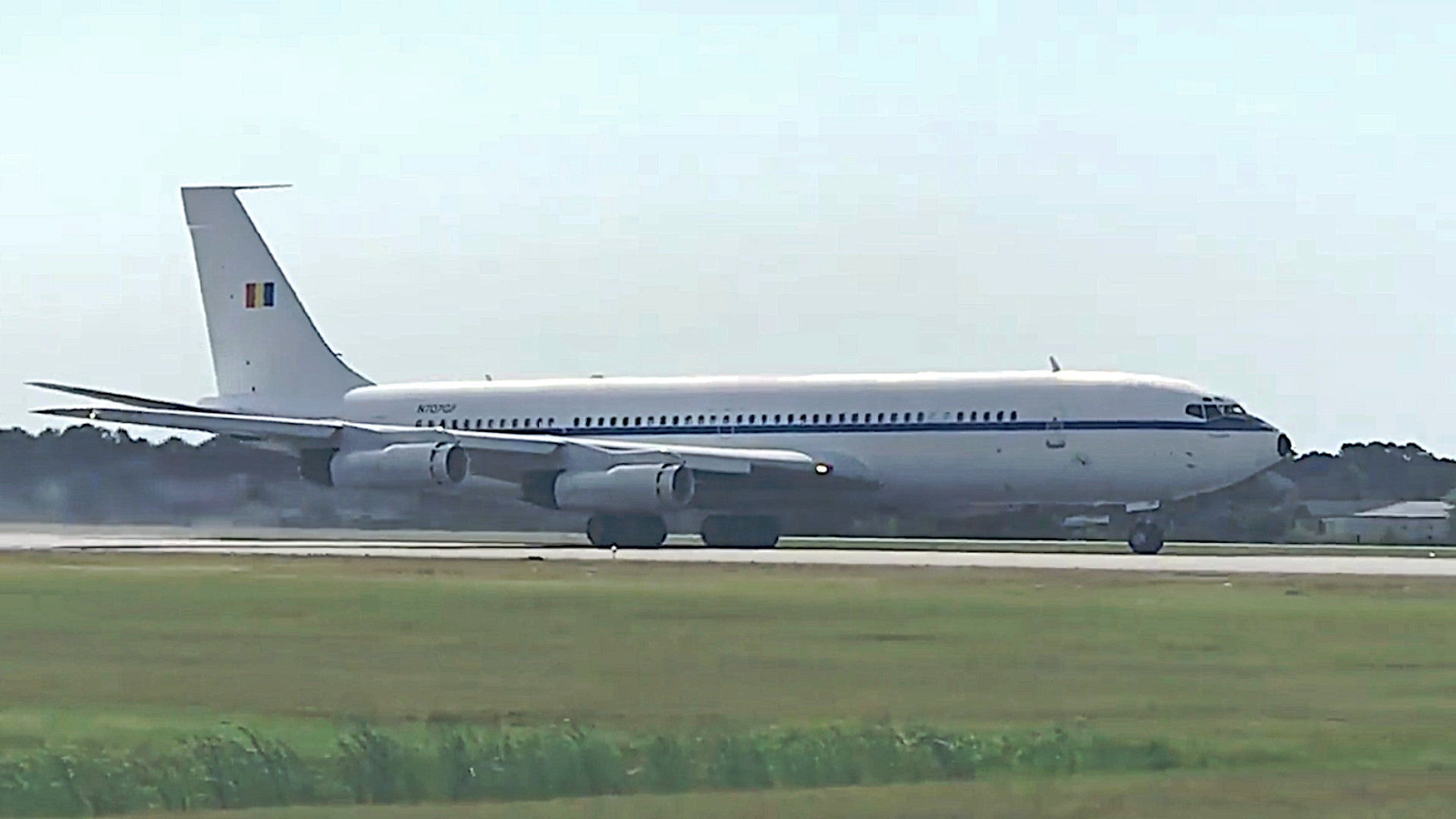A Boeing 707 airliner that once served as a VVIP aircraft for Romanian dictator Nicolae Ceaușescu and his family has recently flown for the first time in almost seven years and is now reportedly in the process of being converted to an aerial refueling tanker. Private air refueling contractor Omega Air owns the aircraft and its return to the skies comes as the U.S. Air Force moves ever closer to hiring contractors to provide these services on a broad scale amid ongoing difficulties with its new Boeing KC-46A Pegasus tankers.
Romanian aviation enthusiast site Boarding Pass
was first to report that the 707, which carries the U.S. civil registration number N707GF, had left Brunswick Golden Isles Airport in Georgia, where it had been in storage, and was heading to San Antonio, Texas. The aircraft still has the overall white with blue cheatline livery, as well as Romanian national flag on the tail, that it did before Omega Air acquired it. The large “ROMANIA” titles that it previously had on either side of the forward fuselage have been removed.
Omega Air already has two KC-707 tankers configured with probe-and-drogue style aerial refueling systems. It also has a probe-and-drogue configured McDonnell Douglas KDC-10 in service and acquired another one of these aircraft with a boom-type refueling system last year. The latter aircraft is the first boom-equipped tanker to join a private contractor’s fleet.
The War Zone has already reached out to the company for more details about what it has planned now for N707GF.


Turning N707GF into a tanker would add an interesting new chapter to the plane’s already intriguing history. Starting in 1974, Romania, then under the control of totalitarian Communist dictator Nicolae Ceaușescu and a member of the Soviet Union’s Warsaw Pact alliance, acquired a total of four Boeing 707s for its national airline TAROM. One of these was the jet that Omega Air now owns, which previously carried the Romanian registration code YR-ABB.
Though firmly within the Soviet Union’s orbit, Ceaușescu had broken with officials in Moscow on a number of occasions before and after buying the 707s, notably including continuing to have diplomatic relations with Israel after the Six Day War in 1967 and refusing to contribute forces for the invasion of Czechoslovakia in 1968. When it came to civil aviation, in the 1970s, Romania also entered into a deal with the British Aircraft Corporation in the United Kingdom to buy and then license produce a number of BAC-111 airliners, also for TAROM, which otherwise operated only Soviet-made designs.
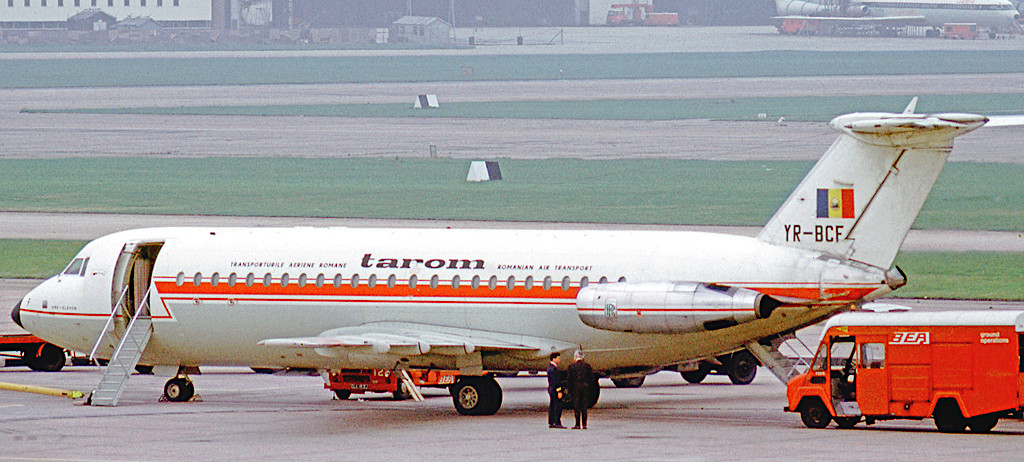
In 1976, TAROM has set aside two of the four 707s specifically to fly Ceaușescu, as well as his family and members of his inner circle, around, including on state visits. The interiors of these aircraft were also upgraded to match their VVIP role, and the Romanian dictator’s luxurious tastes, and were “fitted out like the U.S. President’s Air Force One,” according to one 1990 article. The TAROM titles on the jets were replaced by “Republica Socialista Romania” on the sides of the fuselage and the Romanian national flag took the place of the airline’s logo on the tail. The red-and-white TAROM livery of the day remained otherwise unchanged.
The exact internal configuration is unclear, and it is isn’t possible that the planes had the kind of advanced communications and other capabilities of the U.S. Air Force’s 707-based VC-137 Air Force Ones that were in service at the time, but the American jets may well have influenced the modifications, at least to some degree. President Richard Nixon made one of the VC-137s available to the Romanian dictator during a two-day tour of the United States in 1970.

As the Soviet Union and Warsaw Pact began to collapse in the late 1980s, Romania began to experience political upheaval of its own. In December 1989, a popular revolution led to the ouster and execution of Ceaușescu and his wife Elena and a transition to democratic rule.
In the immediate aftermath, YR-ABB found its way into the fleet of LAR, another Romanian state-owned airliner that the country had established in 1975 specifically to serve tourist destinations and operate charters. It was reportedly leased to an airline in Suriname between 1991 and 1992 and then again to Pakistan’s Aero Asia International for three months in 1995.
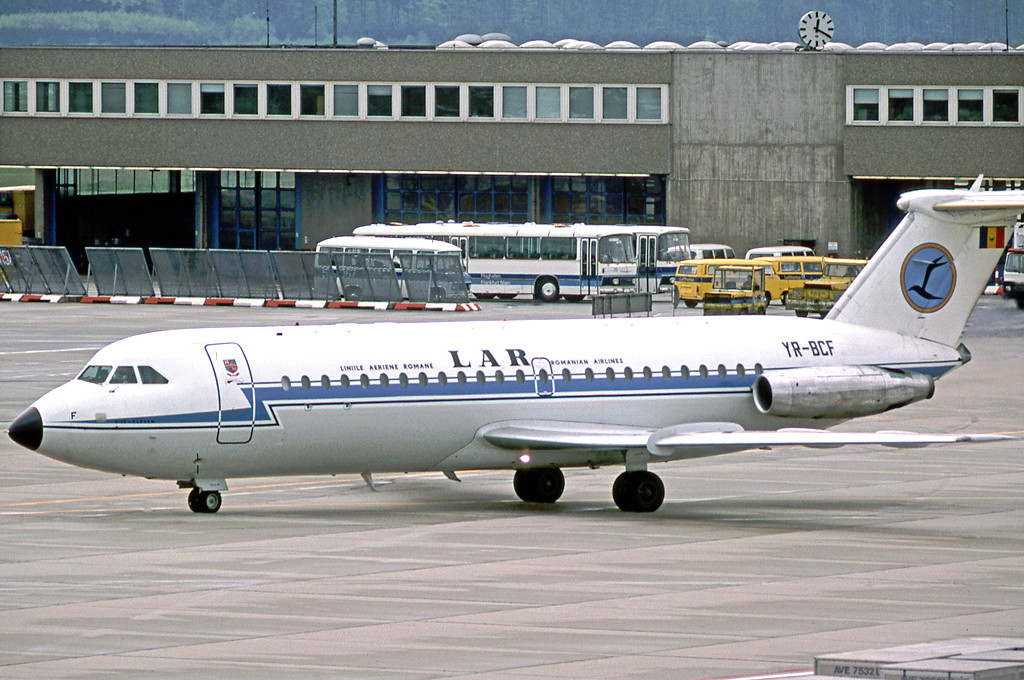
LAR ceased operations in 1997 after which the former VVIP 707 joined Romavia’s fleet. The Romanian Ministry of Defense had established Romavia, the country’s first post-revolution state-owned airline, in 1990. As part of Romavia, YR-ABB served again as the official plane of the Romanian President. Sources differ on exactly when the plane stopped serving in this role, but it had been retired by 2010. Two years later, Omega Air acquired it for approximately two million Euros, or around $2.6 million at the exchange rate at the time. The plane has not flown since 2013, the year that it arrived at Brunswick Golden Isles Airport.
It’s not clear why Omega Air might be looking to covert the aircraft into a tanker now, but the U.S. Air Force’s Air Mobility Command, in cooperation with U.S. Transportation Command (TRANSCOM), has been increasingly more engaged with private contractors in recent months about hiring them to provide aerial refueling support across the U.S. military. The Air Force’s existing KC-135R Stratotanker and KC-10A Extender tankers are configured with booms, which is the primary aerial refueling system that service employs.
However, the KC-135R can be configured with a drogue on its boom and drogue pods under its wings, while the KC-10A has a retractable drogue in its tail. This allows them to refuel U.S. Navy and Marine Corps aircraft, as well as those belonging to foreign allies and partners, that use the probe-and-drogue refueling method, which they do regularly during combat and non-combat missions.

In December 2019, AMC hosted an industry day event at Scott Air Force Base in Illinois to discuss various requirements and available capabilities. A total of 14 companies, including Omega Air, were present at that gathering.
The Air Force and TRANSCOM have been refining possible contractor air fueling requirements for some time and continues to do so. At present, it is interesting private companies being able to provide up to around 25,000 flight hours of non-combat aerial refueling support a year. This would include refueling aircraft during training exercises, test and evaluation activities, non-combat transits, and the delivery of aircraft under the Foreign Military Sales program.

The Air Force is most interested in hiring companies that can provide tankers capable of being configured for both probe-and-drogue and boom-type refueling operations, as necessary. However, Omega Air’s drogue-equipped tankers could still meet Air Force requirements to support non-Air Force aircraft.
You can see the full draft performance requirements, as of December 2019, below.
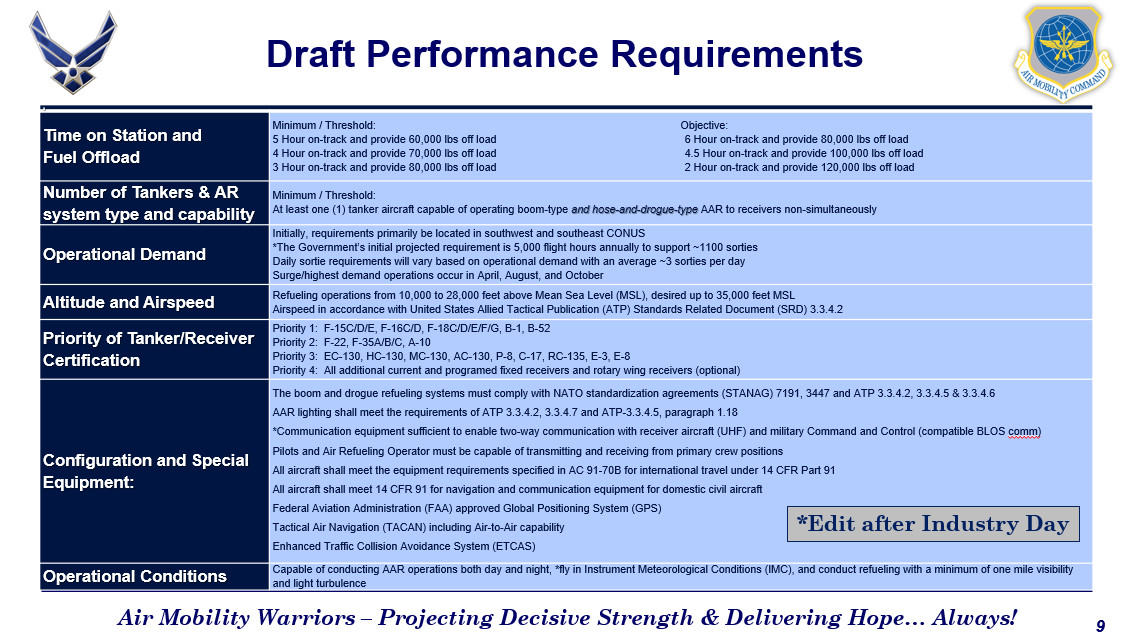
Persisting issues with the Air Force’s new KC-46As, which the service says it will not use for routine aerial refueling operations in combat or otherwise until significant fixes are made to the design, have been a major driving factor in the push toward hiring private contractors. The Pegasus also has a retractable drogue in the rear of the aircraft and is slated to be certified to carry drogue pods operationally this year.

Just last month, the Air Force revealed that the Pegasus’ fuel system leaks excessively. This is the latest major deficiency with the aircraft, which already has serious issues associated with its refueling boom and the complex Remote Vision System (RVS) that boom operators employ to see what is happening at the rear of the aircraft while connecting with receiving aircraft. On April 2, Boeing and the Air Force finally reached an agreement that the company would develop and deliver a completely redesigned RVS 2.0 and refit it to the dozens of existing aircraft the service already has at its own cost. The KC-46A contract is firm, fixed price, which already led Boeing to have to pay hundreds of millions of dollars of its own money on various fixes and modifications to the design.
“RVS 2.0 will include 4K color cameras with proper viewing geometry, operator stations with larger screens, a laser ranger for refueling aircraft distance measurement and boom assistance augmented reality,” according to an Air Force statement. “With the help of scientists and engineers from both enterprises, the Air Force will lead design reviews and approve specifications to drive the partnership toward initial fielding in 2023.”
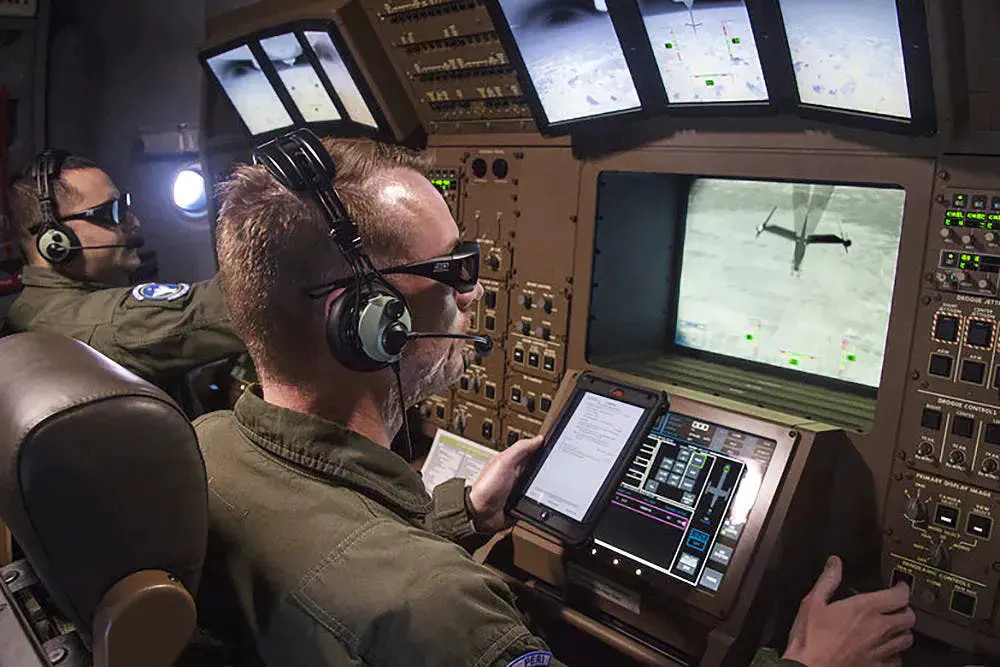
In the meantime, the Air Force will have to continue relying on its existing and aging fleets of KC-135R and KC-10A tankers to refuel both its own aircraft and those belonging to the Navy and Marine Corps. The difficulties with the KC-46A has also forced the service to backtrack on plans to retire some of those older aircraft in the coming year.
Private contractors could also help fill gaps in aerial refueling capacity, and do so in a cost-effective manner, especially for non-combat missions, freeing up KC-135Rs and KC-10As for more demanding missions. This is something the War Zone has explored in depth in the past. Omega Air has already been supporting Navy training and test and evaluation activities for years now, too.
AMC says that it could potentially begin soliciting bids for a private aerial refueling contract by June. Whether the Air Force intends to keep to that schedule, or if it even remains tenable given various factors, including the COVID-19 pandemic, is unclear.
If the Air Force, or another service, does proceed with a major contract aerial refueling deal, or if the Navy continues its relationship with Omega Air, American or allied military aircraft may eventually find themselves taking on fuel from was once the personal jet of a Romanian dictator.
Contact the author: joe@thedrive.com
